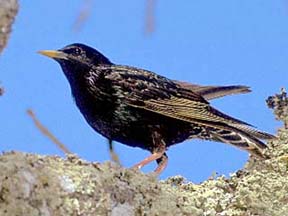


For the birds FOR YEARS, CLASSICAL music enthusiasts have believed that Mozart, Vivaldi and Beethoven composed some of the greatest works in Western musical history. The music is as great as ever, of course. The "authors," however, may well have been plagiarists.
Did Mozart pilfer
By Scott Vogel
from a starling?
Star-BulletinResearch into the writing of Mozart's 17th piano concerto, Vivaldi's flute concerto and Beethoven's D major violin concerto has led scholars to a surprising collection of ghostwriters whose anonymity was carefully maintained. Until recently.
The true authors, it seems, are a starling, a goldfinch and a European blackbird, respectively.
Luis Baptista, who until his death last year was curator of ornithology and mammalogy at the California Academy of Sciences, spent years studying the relationship between music and bird calls. Key to his thesis of artistic theft, however, was the discovery that singing birds have favorite tunes which they often "pass down" from generation to generation. Blackbirds, for instance, have been teaching their progeny the opening bars of a Beethoven concerto for centuries. It is at least conceivable, reasoned Baptista, that Beethoven first heard the catchy ditty from them, rather than the other way around. Other suspicious musical borrowings include a Bartok piano concerto, parts of which bear a striking resemblance to sounds made by certain North Carolina birds, and a Bach fugue in which the counterpoint sounds like a conversation between a cuckoo and a chicken. But now we're getting off the subject.
In concert: 4 p.m. Sunday and 7:30 p.m., Tuesday HONOLULU SYMPHONY
Place: Blaisdell Concert Hall, 777 Ward Ave.
Call: 792-2000
Cost: $15 to $55
In fact, careful perusal of historical evidence seems to exonerate Mozart, whose relationship with his pet starling was nevertheless quite intimate (he even recited poetry at the bird's funeral). The starling is known to have sung the opening bars of the 17th piano concerto's final movement, however imperfectly (Mozart noted that he tended to change sharps to flats), and may well have suggested variations to the composer. But avian admirers bent on embarrassing Mozart are in for a disappointment. The original manuscript of his concerto is dated April 12, 1784. The composer's diary, however, indicates that the starling was not purchased until May 27th. In the war between man and beast, score one for our side.
Music fans and birders with any lingering doubts, however, are encouraged to attend Sunday's Honolulu symphony program (repeats Tuesday), when Jeffrey Kahane conducts and plays the Mozart piano concerto in a program that also includes works by Barber and Brahms. There's no word on whether the latter two composers purloined from parakeets or robbed a robin, but then neither met Mozart's feathered friend, who by all accounts was a quite a remarkable bird.
Not merely the muse of composers, European starlings (the species' actual name) have inspired some of history's greatest authors, including Shakespeare, and yet they are not held in terribly high regard today. In a way, this is due to Shakespeare, and also the wealthy entrepreneur who brought 50 pairs of the birds to New York City in 1890. According to biologist Terry Rich (whose full article can be found at www.mynahbird.com), the businessman, an equal fan of Bard and bird, endeavored to import to America every single species mentioned in the Bard's plays. Starlings in particular thoroughly embraced their adopted home, colonizing the mainland in just 60 years. And though not found in Hawaii, there are now more than 200 million of the birds in North America, so many that they are considered a nuisance in many cities.
Which is a shame, since starlings have quite an interesting vocal apparatus, a two-part voicebox allowing them to sing two tunes at once. It's the complexity of the starling instrument that once again leads us back to Mozart, and an unusual composition entitled "A Musical Joke" which has long puzzled scholars. The piece, a sextet for strings and two horns, contains a number of off-key moments, much repetition, and a finale written in two keys. In short, it sounds distinctly un-Mozart-like. Until, that is, you consider when it was written -- a mere eight days after the death of the composer's beloved starling.
Click for online
calendars and events.